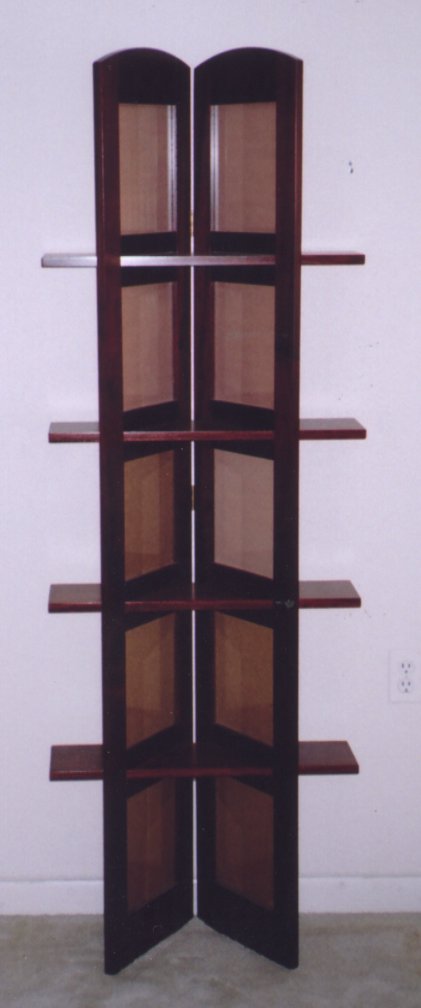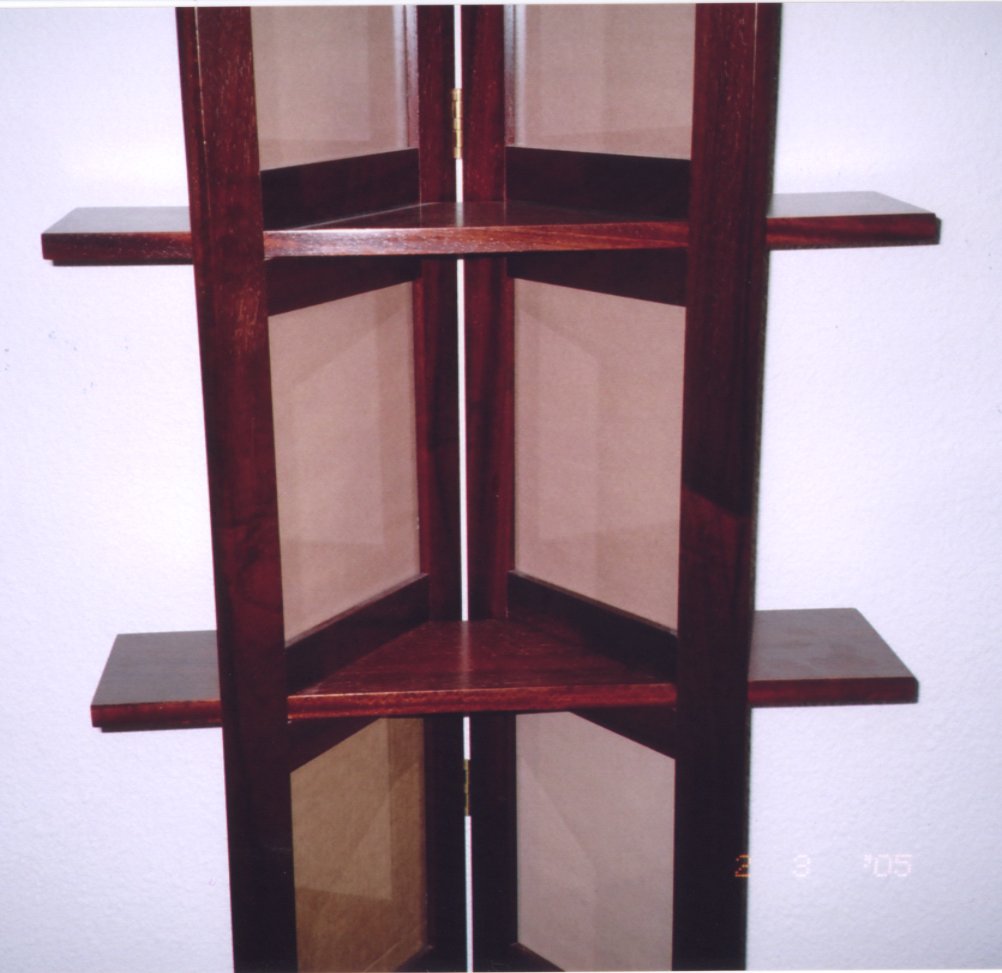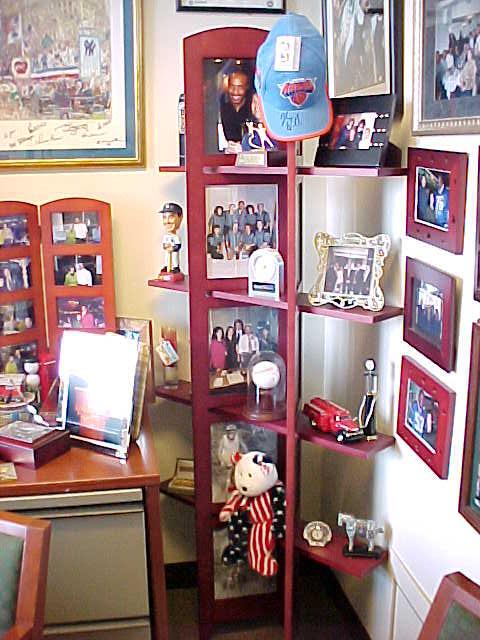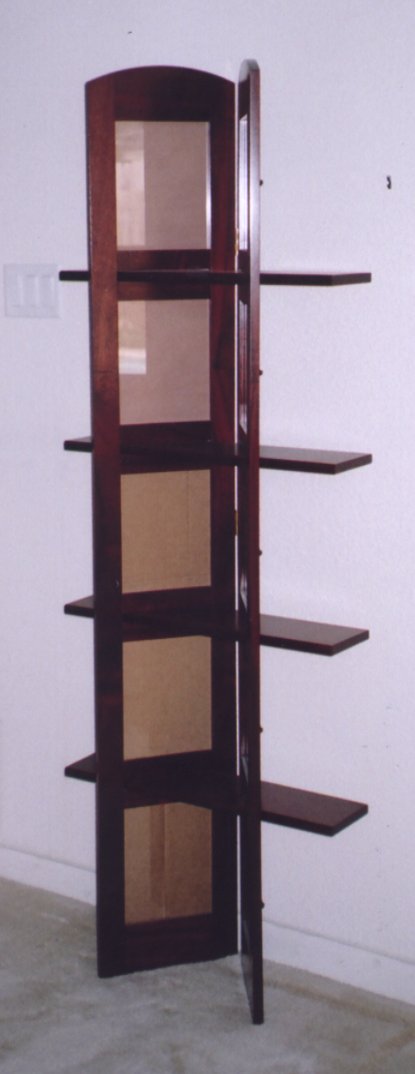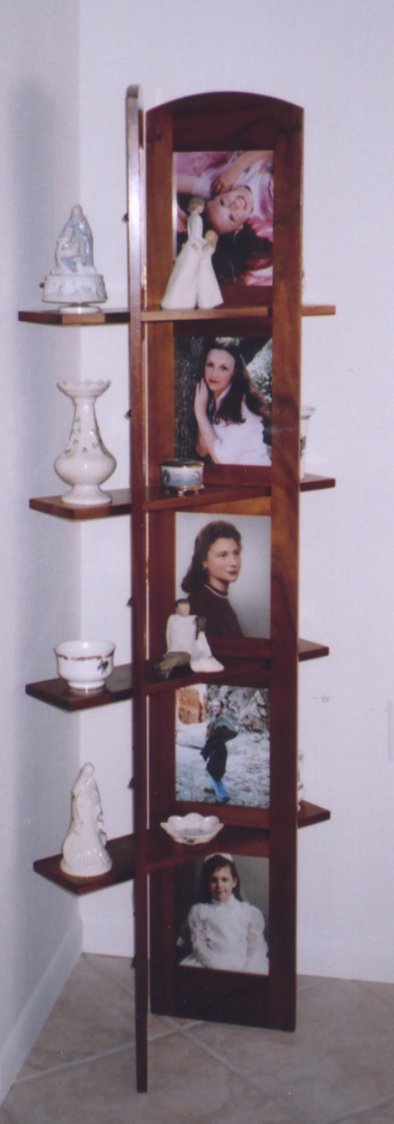Specifications
There were 10 of these units produced, each of a different type of
wood. The woods used were: cherry, red oak, koa, mahagony, teak,
walnut, padauk, bubinga, purple heart, wenge. All shelves have an
oil-based finish, except the koa which is shellac. They stand
approximately 6 feet high and hold 10 8" x 10" pictures.
Story
It was over two years from the time that this project was started
(wood purchased) until it was completed. It started with a request
from my mother for a piece of furniture that she saw in a co-worker's
office. She sent me the picture of the original (see right), which
was the sole thing I had to work from.
I figured if I was going to go through the trouble of the setup to
create this, then it would be relatively easy to make a lot of them,
and offer them as gifts to various relatives. In addition, I was
looking to expand my horizons and work with different types fo wood to
see what the differences were. So, the plan was to make 10-12 of
these units, each out of a different type of wood.
I set out a design to match this picture, not knowing exactly how
the wood was joined and such. The hardest part was figuring how to
join the horizontal pieces to the vertical ones without any hardware
showing, but yet string enough to support a lot of weight. I didn't
solve this problem until after I bought the lumber.
There was some amount of tricky cuts needed to make the horizontal
pieces joined the vertical pieces while still having a cutout for a
piece of glass for the frame. I decided to make a quick-n-dirty
prototype out of scrap pine. I only build one side of the frame and
discarded this prototype after I was satisfied I could get the cuts
correctly aligned.
I went to a local woodworking/lumber place that had dozens of
types of woods, including many "exotics" (as they call them). I found
11 types of wood which I had either never made something out of before
or that I thought looked really interesting. The final list of woods
I bought were:
-
cherry, red oak, koa, mahagony, teak, canary wood, walnut, redheart,
padauk, bubinga, purple heart, wenge
The initial phases of this project consisted of planing and
sawing. Given the quantity of wood and the amount of cutting, this
was a major operation which generate a lot of sawdust. After the
fact, when I felt miserable for a few days after this, I did some
research and learned that for at least a few of these woods, the
sawdust is poisonous. So I learned that a mask is probably a good idea
in the future.
The prototype (red oak) was ready the next year in time for
Christmas. I needed to ship this from Texas to New York, which wound
up costing $100. While the other units where already rough cut, this
finished prototype was what I paraded around to relatives to show them
what they would receve the following year.
Upon beginning to make the other 11 units, and my experiences with
the prototype, I realized that the redheart and canarywood units could
not be made. The vertical units (being 6 feet long) were too
warped. I tried some strightening techniques and looked at steaming
techniques that boat builders do, but in the end decided to simply
eliminate these from the list and hope I could make use of this wood
for some other project. Though the fact that the boards were already
rough cut into these long and short narrow pieces, I was eventually
able to use most of it in these projects: Snack Tables, Decorative Table, Picture Frames.
The sanding, assembly and finishing operations on the other 9 units
would up being a bear of a project. There is no savings in these
steps by making these in bulk, plus some of the woods were really hard
to work with. I'll never make this many of something again, though I
do not regret having done this once.
The delivery of the units was another big issue. At $100 each to
ship 7 units (2 stayed in Texas, and the red oak was already there) to
New York, I found it cheaper to buy a hitch, rent a trailer, make a
fixture to prevent breakage and drive them up there when they were
done.
Miscellaneous Notes/Thoughts
- It was while creating this web page that I first looked back at the original picture. What I see is that the original has pictures that are wider than than an 8"x10" picture (something I was inherently assuming they must be). Because of this, the shelves could be longer. The shelves on my frames were shorter due to the stability issue with the smaller footprint.
- My experiences with the different types of wood:
- cherry - cuts easy, finishes well, burns easy, gets much darker with age.
- red oak - cuts easy, finishes well, no problems.
- koa - I call this the "titanium" of the wood world. It was very hard, yet very light. With a shellac finish it looked beautiful. I very pretty wood, but not that hard to work with.
- mahagony - beautiful to work with and looks really nice afterwards.
- teak - beautiful small, oily surface, really nice wood to work with.
- walnut - beautiful smell, cuts well, but I am not too fond of the final appearance.
- paduak - really, really beautiful reddish-orange. Makes areal mess of everything since the red sawdust gets everywhere. Relatively easy to work with.
- bubinga - This looks really nice when finished, but it is a bit difficult to work with. Very hard and tears easily.
- purpleheart - This wood has an unnatural color to it (few people believe it is naturally that purple). It is an extremely dense wood (very heavy) and a major pain in the neck to work with. Plan on going through a lot of cutters, drills and sandpaper with this wood. Not sure if I'd work with this again, though I have some extra scraps I may do something with.
- wenge - Also a major pain to work with, with the added annoyance of splintering easy. The final product gives you something close to an ebony color, so it is a god poor-man's ebony (though it is not really cheap, only cheaper than ebony). I don't think I'll make anything out of this project again with the exception of the few scaps I have leftover.
- The dilema about joining the the short horizontal pieces to the long vertical pieces was solved by using pocket hole screws. The back looks a bit ugly (I didn't plug these due to laziness), but I determined that I could not hold the needed tolerances with a dowel arrangement. Maybe a biscuit thingy would have been the right thing, but I never used one of these before.
 Cassandra.org
Cassandra.org
